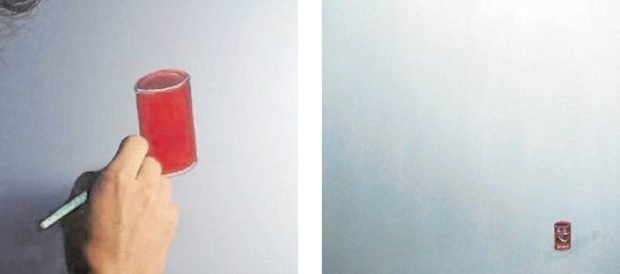
ART IMITATES LIFE This minimalist artwork depicts the “too minimal aid” provided by the government. —JADIE REGALA PASAYLO
MANILA, Philippines — For fine arts student Jadie Regala Pasaylo, art is essential during these critical times, when people are restrained in their homes while battling a pandemic.
So when he learned about a nationwide art competition sponsored by the Government Service Insurance System (GSIS), he wanted to submit an art piece that would portray Philippine society during the pandemic.
On April 19, Pasaylo emailed to the GSIS a photo of his 122 centimeters by 91 cm acrylic painting called “Maluwag na Kaginhawaan,” or Empty Relief, a minimalist artwork depicting the “too minimal aid” provided by the government.
A can of sardines — a staple of relief packs, or “ayuda,” given during calamities — occupies the lower right corner of the canvas. The small red can stands out as the solitary image that draws the viewer’s attention as it evokes the feeling of emptiness and deprivation.
He said the minimalist style—devoid of colorful patterns and “eye-catching images”—best fitted his artwork because it highlights the bigger story behind it. The red can of spicy sardines depicts the burning rage of Filipinos who are rendered powerless in society, he said.
“I based my artwork on the struggle of Filipinos in this time of crisis. It is apparent that Filipinos experience negligence and hunger. I am a testament to this experience, as I haven’t received any ayuda from the barangay,” Pasaylo told the Inquirer.
Pasaylo, 21, knows how it is to be poor since birth. He finished high school by, among other things, selling paintings. His mother earns only P3,000 monthly as a house helper, not enough for the three of them in the family, which includes his grandmother.
GSIS art competition
After the pandemic struck, he had to stop his second year as a studio arts major at the College of Fine Arts of the University of the Philippines.
The GSIS art competition ran with the theme “Alay na Ginhawa sa Gitna ng Pandemya” with P300,000 worth of prizes for winning entries.
Pasaylo submitted his painting as an entry in the representational category of the competition. Organizers informed participants they would receive an email 10 days after submitting their entries.
But Pasaylo did not get any email. Others had received notices of acceptance of their entries. With still no word from the organizers, he opted to just show his painting on his Facebook page in early May.
“Believing that my artwork wasn’t accepted by the institution, I decided to just post my artwork to still deliver [its message]. The theme is an all-encompassing idea that should address the real situation of the country, especially the struggle down the grassroots,” Pasaylo said.
His post has so far earned more than 10,000 likes and around 5,000 shares.
Pasaylo was convinced his work failed to pass the elimination round, until the GSIS posted an advisory that the contest “is currently ongoing and will be completed on May 12.”
He only received a confirmation that his two entries qualified for the next round of the competition on May 8, or four days after his post went viral.
Social commentary
People who saw his artwork online praised the way he used art to make a social commentary on the state’s pandemic response and its impact on the public.
“Art is expected to be brimming with vivid colors and scrupulous details. However, art shouldn’t be limited to the typical forms and styles. Art becomes cathartic, and an entity that can never be stopped, even by a lethal virus,” Pasaylo said.
He said he wanted to show how Filipinos were devoured by the swelling void of hunger, negligence and apathy.
“Ayudas are like Filipinos: mistreated and mishandled,” he said.
He also considered his artwork as a form of protest against the inefficient distribution of aid under the government’s social amelioration program, which his own family in Antipolo experienced.
He once asked his neighbors for canned goods and rice just to survive.
Pasaylo eventually sold his painting to a private individual.
“Although I stood my ground that I will not sell the painting, I realized that my current situation would not allow me to preserve my art. Luckily, I found someone to whom I can entrust my work,” he said.
‘Insensitive post’
In a Facebook post that was later deleted, Fidel Sarmiento of the Art Association of the Philippines, the GSIS partner in the art contest, said an entry would be disqualified only if it was not submitted within the deadline.
“If he (Pasaylo) was impatient for the results of the screening, he should have called the organizer to find out if his entry was accepted,” Sarmiento said in Filipino.
He criticized the young artist for portraying himself as “being oppressed.”
In a statement on Friday, the Concerned Artists of the Philippines (CAP) condemned Sarmiento’s “malicious, insensitive and unprofessional post,” saying it was an attack against the young artist and implied that Pasaylo’s concern about his “disqualification” was false.
“Instead of maligning Pasaylo, he should have reached out to the young artist personally and explained the process and the ways how to contact them regarding the submission of artworks,” CAP said.